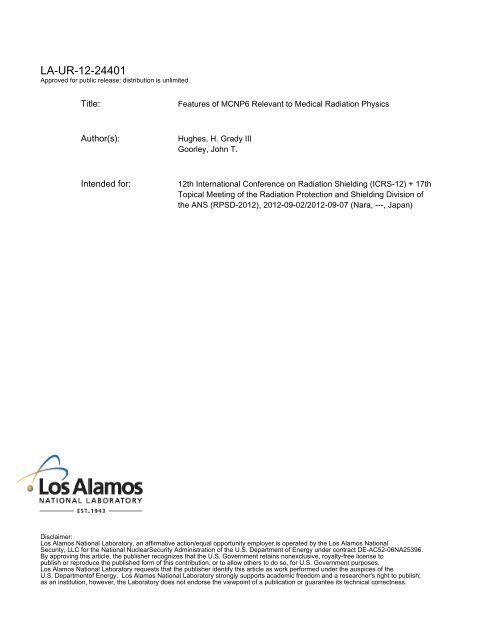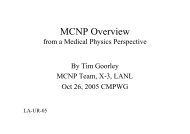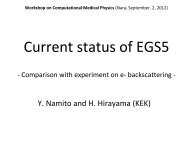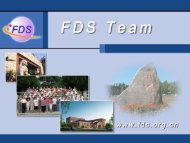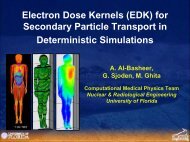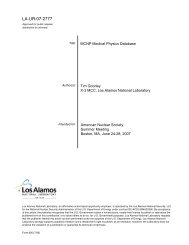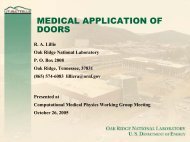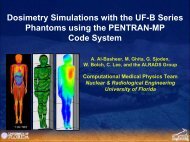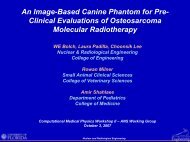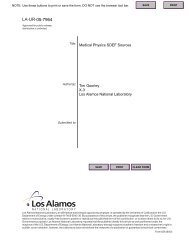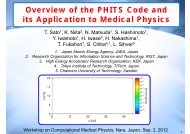Grady Hughes LA_UR_1.. - Computational Medical Physics Working ...
Grady Hughes LA_UR_1.. - Computational Medical Physics Working ...
Grady Hughes LA_UR_1.. - Computational Medical Physics Working ...
Create successful ePaper yourself
Turn your PDF publications into a flip-book with our unique Google optimized e-Paper software.
<strong>LA</strong>-<strong>UR</strong>-12-24401Approved for public release; distribution is unlimited.Title:Features of MCNP6 Relevant to <strong>Medical</strong> Radiation <strong>Physics</strong>Author(s):<strong>Hughes</strong>, H. <strong>Grady</strong> IIIGoorley, John T.Intended for:12th International Conference on Radiation Shielding (ICRS-12) + 17thTopical Meeting of the Radiation Protection and Shielding Division ofthe ANS (RPSD-2012), 2012-09-02/2012-09-07 (Nara, ---, Japan)Disclaimer:Los Alamos National Laboratory, an affirmative action/equal opportunity employer,is operated by the Los Alamos NationalSecurity, LLC for the National NuclearSecurity Administration of the U.S. Department of Energy under contract DE-AC52-06NA25396.By approving this article, the publisher recognizes that the U.S. Government retains nonexclusive, royalty-free license topublish or reproduce the published form of this contribution, or to allow others to do so, for U.S. Government purposes.Los Alamos National Laboratory requests that the publisher identify this article as work performed under the auspices of theU.S. Departmentof Energy. Los Alamos National Laboratory strongly supports academic freedom and a researcher's right to publish;as an institution, however, the Laboratory does not endorse the viewpoint of a publication or guarantee its technical correctness.
Features of MCNP6 Relevant to<strong>Medical</strong> Radiation <strong>Physics</strong>H. <strong>Grady</strong> <strong>Hughes</strong> and Tim GoorleyLos Alamos National Laboratory12 th International Conference on Radiation Shielding (ICRS–12)17 th Topical Meeting of the Radiation Protection and ShieldingDivision of the American Nuclear Society (RPSD–2012)Workshop on <strong>Computational</strong> <strong>Medical</strong> <strong>Physics</strong>September 2–7, 2012Nara, JapanOperated by the Los Alamos National Security, LLC for the DOE/NNSA
AbstractMCNP (Monte Carlo N-Particle) is a general-purpose Monte Carlo code forsimulating the transport of neutrons, photons, electrons, positrons, and morerecently other fundamental particles and heavy ions. Over many years MCNPhas found a wide range of applications in many different fields, includingmedical radiation physics. In this presentation we will describe and illustratea number of significant recently-developed features in the current version ofthe code, MCNP6, having particular utility for medical physics. Among theseare major extensions of the ability to simulate large, complex geometries,improvement in memory requirements and speed for large lattices,introduction of mesh-based isotopic reaction tallies, advances in radiographysimulation, expanded variance-reduction capabilities, especially for pulseheighttallies, and a large number of enhancements in photon/electrontransport.Operated by the Los Alamos National Security, LLC for the DOE/NNSASlide 1
MCNP HistoryMCNPXMCNP5MCNP61940s 1977 2001 2011• Monte Carlo transport of particles– MCNP5 - neutrons, photons, electrons– MCNPX - neutrons, photons, electrons + many more particles & ions– MCNP6 - merged code + more, release in 2012• For 30+ years, MCNP & its data libraries have been supportedby the Monte Carlo team at <strong>LA</strong>NL– Roots of MCNP go directly back to von Neumann, et al.– Continuous development, support, R&D, V&V
MCNP Development Team• Los Alamos groups XCP–3 and NEN–5Forrest Brown Jeffrey Bull Larry Cox Joe DurkeeJay Elson Michael Fensin Tim Goorley <strong>Grady</strong> <strong>Hughes</strong>Michael James Russell Johns Brian Kiedrowski Roger MartzStepan Mashnik Gregg McKinney Jeremy Sweezy Trevor WilcoxTony Zukaitisactive retirees: Tom Booth Art Forster John HendricksDenise Pelowitz Dick Prael Laurie Waters• Other Los Alamos groupsXCP–5XCP–7Materials and Physical DataTransport Applications• External CollaboratorsUniversity of New MexicoUniversity of MichiganSandia National Laboratory… and many othersUniversity of Southern MississippiLawrence Livermore National LaboratoryCEA (France)Operated by the Los Alamos National Security, LLC for the DOE/NNSA
What Can MCNP Do?Detailed models of geometry & physics– General 3D combinatorial geometry– Repeated structures– Lattice geometries– Unstructured mesh geometries (tet, hex)– Geometry, cross section, tally plotting– ENDF/B-VII physics interaction data– Event-generator physics modelsCalculate nearly any physical quantity– Flux and current– Energy and charge deposition– Heating and reaction rates– Response functions– Mesh tallies and radiography images– K-effective, , , , – Fission distributions– Fission product distributionsUnique features for criticality calc’s– Shannon entropy of the fission sourcefor assessing convergence– Dominance ratio, k 1 / k 0– Stochastic geometry– Isotopic changes with burnup> 10,000 users around the world– Fission and fusion reactor design– Nuclear criticality safety– Radiation shielding– Waste storage/disposal– Detector design and analysis– Nuclear well logging– Particle accelerators– Health physics and dosimetry– <strong>Medical</strong> physics and radiotherapy– Transmutation, activation, and burnup– Aerospace applications– Decontamination and decommissioning– Nuclear safeguardsPortable to any computer– Windows, Linux, Mac, Unix– Multicore, clusters, netbooks, ASC, …– Parallel, scalable - MPI + threads– Built-in plottingSupport– Extensive V&V against experiments– Web site, user groups, email forum– Classes: 1 week, ~ 6x / yeargeneral and special topics1 - 4
Features of Interest to <strong>Medical</strong> <strong>Physics</strong>• Extensions for problem size– More cells and surfaces– More detectors and tallies– Histories beyond the 32-bit limit ( > 2 billion )– Lattice tally enhancements– Large lattice improvements– Optional initialization speedups• Enhancements for tallying and visualization– Mesh tallies and mesh-based reaction tallies– Dosimetry and built-in response functions– Radiography tallies• New kinds of geometry– CAD/CAE geometries (e.g. Abaqus)– PARTISN geometries (link to deterministic codes)– Third-party CT → MCNP geometry scripts (old methods)Operated by the Los Alamos National Security, LLC for the DOE/NNSA
Features of Interest to <strong>Medical</strong> <strong>Physics</strong>• Improvements in Transport Capability– Pulse-height tally variance reduction– Condensed-history energy straggling logic– Stochastic geometry• <strong>Physics</strong> Improvements– Photon Doppler broadening (for incoherent scattering)– Create temperature-specific neutron cross-section tables– Photon and atomic relaxation data extensions– Single-event electron transport• On-Line Information– http://mcnp.lanl.gov especially → Publications– <strong>Medical</strong> physics MCNP Primer (<strong>LA</strong>–<strong>UR</strong>–07–4133)– <strong>Medical</strong> database(<strong>LA</strong>–<strong>UR</strong>–08–2468) with ICRP110 phantoms– Contact Tim Goorley (jgoorley@lanl.gov) to discuss or contribute.Operated by the Los Alamos National Security, LLC for the DOE/NNSA
Extended Limits on Problem SizeMCNP5 <strong>1.</strong>51 MCNP5 <strong>1.</strong>60and earlier and MCNP6Cell numbers 99,999 99,999,999Surface numbers 99,999 99,999,999Material numbers 99,999 99,999,999Universe numbers 99,999 99,999,999Tally numbers 999 9,999Geometry levels 10 20Cell complexity (MLGC) 1,000 9,999<strong>UR</strong>AN universes 2 unlimitedOperated by the Los Alamos National Security, LLC for the DOE/NNSASlide 7
Large Lattice Improvements: Tally Speed• Under certain conditions, runtimes can be significantlyreduced (5-500 times shorter, depending on problem).• Stringent Conditions:– 1st level hexahedral lattice.– F4, optionally with DE–DF, each instance addressing the lattice.– No DXTRAN, GEB, E/C/T bins, flagging, WWG, perturbations, etc.• MCNP will attempt to determine if these conditions are metand will attempt to use the enhancement if appropriate.Messages either way. Fast and slow runs will track.• No tallied nested lattice, tallied partial lattice index range, orself-referencing fill entry. See <strong>LA</strong>-<strong>UR</strong>-04-3400.Operated by the Los Alamos National Security, LLC for the DOE/NNSASlide 8
Large Lattice Improvements: Memory Use• Increase voxel limitfrom ~20 million to~800+ million (withrecompilation).• Reduce startup timesfrom days to a fewhours.• Windows 32-bit OSlimit: 2 Gbytes memoryper program. (Use 64-bit chip & OS)Megabytes of Memory9008007006005004003002001000MCNP5_RSICC_<strong>1.</strong>20MCNP5 VIP Modifications0 50 100 150 200 250 300 350 400Millions of Voxel CellsOperated by the Los Alamos National Security, LLC for the DOE/NNSAGoorley, “Issues Related to the use of MCNP code for anExtremely Large Voxel Model VIP-MAN,” Monte Carlo 2005,Chattanooga TN.Slide 9
Another View of Mesh Plots: Particle TracksSlide 10Operated by the Los Alamos National Security, LLC for the DOE/NNSA
Electron Energy Straggling ImprovementsDBCN 17J 0. DBCN 17J <strong>1.</strong>DBCN 17J 2.Slide 11Operated by the Los Alamos National Security, LLC for the DOE/NNSA
Stochastic Geometry• On-the-fly randomtranslations of embeddeduniverses in lattice• Developed for pebblebed reactors.• <strong>Medical</strong> physicsapplications?– Alveoli– Sinuses– Bone marrow• Use <strong>UR</strong>AN card– See MCNP5 ManualOperated by the Los Alamos National Security, LLC for the DOE/NNSAFuel kernel displaced randomlywithin lattice element each timethat particle entersImage of thestochasticgeometry offuel kernelsfrom MCNP5plotterForrest Brown, “Monte Carlo Methods and MCNP CodeDevelopment” Monte Carlo 2005, Chattanooga TN.Slide 14
Photon Doppler Broadening• Released in MCNP5, RSICC_<strong>1.</strong>14• Incoherent Compton event,includes electron binding energy.• Causes reduction of the photon’stotal scattering cross section in theforward direction.• Causes broadening of photons’energy spectrum.• Important for E p < 1 MeV.• Bug fixes in MCNP5, RSICC_<strong>1.</strong>40,MCNP5, RSICC_<strong>1.</strong>60, and inMCNP6.Slide 15Operated by the Los Alamos National Security, LLC for the DOE/NNSA
Temperature-Specific Neutron Cross Sectionsfrom MAKXSF• Now part of the cross-section library managerprogram MAKXSF• Create cross-section tables at new temperatures– Doppler broaden resolved resonance data to highertemperature– Interpolate unresolved resonance probability tables to newtemperature– Interpolate S(α, β) thermal data to new temperature• Create new xsdir file which includes the changedcross-section tables.Operated by the Los Alamos National Security, LLC for the DOE/NNSASlide 16
Photon EnhancementsOperated by the Los Alamos National Security, LLC for the DOE/NNSAENDF/B VI.8• Extension of existing data: from ≥ 1 keV down to ≥ 1 eV– Coherent scattering– Incoherent scattering– Photoelectric absorption• New kinds of photoatomic data– Subshell-wise photoelectric cross sections– Detailed sampling of initial vacancy now possible– Complete information for electron subshells– Binding energies, electron populations, transitions, etc.• Extended scattering form factors– Coherent and incoherent scattering– Complete range of energy and angle– Accurate interpolation (especially for coherent scattering)• Cold, neutral, atomic target materials Z = 1 … 100Slide 17
Electron EnhancementsOperated by the Los Alamos National Security, LLC for the DOE/NNSAENDF/B VI.8• Cold, neutral, atomic target materials Z = 1 … 100• Microscopic electron cross sections down to 10 eV• Electron elastic scattering– Electron angular distribution as function of electron energy• Atomic excitation– Electron mean energy loss as function of electron energy• Subshell-wise electroionization– Knock-on energy distribution as function of electron energy– Knock-on direction and primary energy loss from conservation• Bremsstrahlung– Photon energy distribution as function of electron energy– Electron mean energy loss as function of electron energy– No photon angular data given (use existing MCNP methods)Slide 19
Zubal Head GeometrySlide 21Operated by the Los Alamos National Security, LLC for the DOE/NNSA
Flux from Incident 1-MeV NeutronsSlide 22Operated by the Los Alamos National Security, LLC for the DOE/NNSA
N14(n,p)C14 ReactionSlide 23Operated by the Los Alamos National Security, LLC for the DOE/NNSA
Zubal Head Phantom: Simulated RadiographCT Based GeometrySimulated RadiographAlexis Lazarine, “<strong>Medical</strong> <strong>Physics</strong> Calculations with MCNP: A Primer”, April 2007. Texas A&MUniversity Masters ThesisOperated by the Los Alamos National Security, LLC for the DOE/NNSASlide 24
Summary• MCNP is a powerful general-purpose Monte Carlo particletransport code benefitting from an extensive program ofdevelopment, validation, and verification.• MCNP6 is the latest and most advanced version of theMCNP code family.• MCNP6 contains a significant and growing set of featuresuseful for medical radiation physics.• The electron/photon transport capabilities of MCNP6 arebeing vigorously extended and improved.Operated by the Los Alamos National Security, LLC for the DOE/NNSA
Concluding HaikuNara Japan ah!Ah ah Nara Japan ah!Nara Japan ah!…possibly adapted from BashōComments?Questions?Slide 26Operated by the Los Alamos National Security, LLC for the DOE/NNSA


